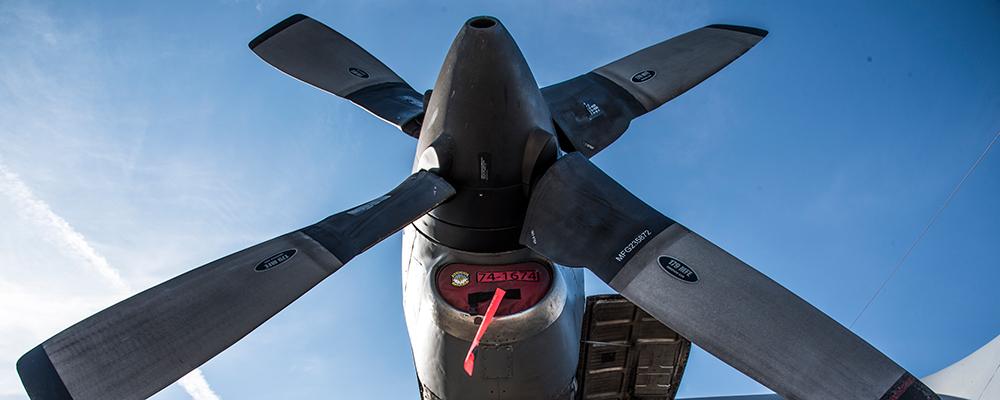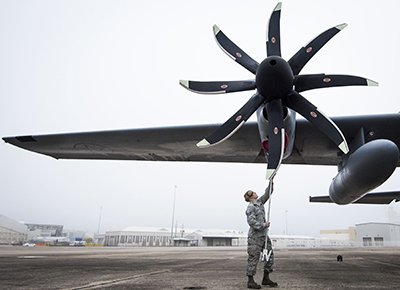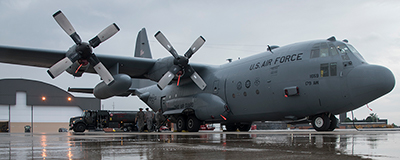
There's a new urgency to modernize the C-130H Hercules cargo plane, the aging workhorse that is the backbone of the Air National Guard’s ability to airlift troops and equipment around the world.
Ongoing efforts have focused on location transmitters and avionics, but the cause of the 2017 crash of a Marine Corps Reserve C-130T, a sibling of the H-model, has cast a spotlight on another item in the mod plan: new propellers.
Intergranular cracks in one of the propellers led to the crash that killed all 16 aboard, according to investigators. The four-bladed prop broke from the engine and slammed into the fuselage, causing the aircraft to break apart over Mississippi.
“The safety of our service members should always be a national priority, and the readiness of our C-130H fleet is a matter of national security.”
—Letter from 17 Senators to Air Force Secretary Heather Wilson
While the propeller at fault was produced in 1983, an Air Force study in January found C-130 props made before 1971 could be especially vulnerable to cracking. The service switched from a manual to a machine manufacturing process in 1971 that resulted in more uniform propellers.
The Air Force temporarily grounded 60 C-130Hs with pre-1971 propellers in February and replaced them with newer props, but propellers of the same vintage that took down the Marine plane are still in wide use, most of them in the Guard.
Those propellers are set to be replaced by the NP-2000 eight-bladed props as part of the overall C-130H modernization effort. Congress provided funds in fiscal 2018 and 2019 to outfit 50 C-130H’s with new propellers; however, there is no start date for the process.
That has some lawmakers calling on the Air Force to accelerate the pace of prop modernization across the C-130H fleet.
In March, 17 senators from states with Guard C-130H units sent a letter to the Air Force Secretary Heather Wilson expressing “grave concern at the perceived lack of urgency from your office in upgrading the legacy propeller system of the C-130H.”
“The safety of our service members should always be a national priority, and the readiness of our C-130H fleet is a matter of national security,” they noted. “U.S. Air Force procurement of the NP-2000 eight-bladed propeller is the obvious solution.”
The Air Force says it is moving forward. Maj. Malinda Singleton, a service spokeswoman, said last month that the service is “assessing the feasibility, schedule and acquisition opportunities” to replace the old propellers.
Meanwhile, commanders of the 16 Guard airlift units that fly the C-130H are waiting for word on the timing of upgrades.
Col. Stephen R. Gwinn, the commander of Connecticut’s 103rd Airlift Wing and chairman of the NGAUS Mobility Air Forces Task Force, just wants to hear a start date. His hope is the effort will commence in fiscal 2020.
The Air Force approach here contrasts with the Marines and the Navy. The Marines put their focus on moving to the new C-130J while the Navy grounded their old Hercs until their propellers could be replaced. The operational realities are also different: Intratheater airlift is a critical Air Force mission and the C-130H provides more than half of the capacity.
“It’s risk versus reward, how much risk is the AF willing to take and still execute the mission,” Gwinn said in an email last month.
That calculus is a little sobering at the unit level. Col. Ed Black, the commander of the Missouri Guard’s 139th Airlift Wing, worries he is putting his personnel at risk anytime one of his four-bladed C-130s takes off.
“They are good props,” he says, “but given the recent events with the [Marine] C-130, there is some doubt in everyone’s mind.”

Samuel King Jr.
The Guard already has a handful of C-130H’s with the NP2000 propellers. One belongs to Wyoming’s 153rd Airlift Wing. It has been a test bed for the complete propulsion system upgrade planned for the H-model. In addition to new propellers, the system includes the new Rolls Royce T56 series 3.5 engines and an electronic propeller-control system.
Testing has proven the new propulsion system more powerful and fuel-efficient. In addition, the eight-bladed propellers eliminate the hydraulics, springs and multiple other moving parts that were essential to the old props, which improves reliability and reduces maintenance. Guard officials believe the propulsion upgrade will eventually pay for itself in lower fuel and maintenance costs.
The Air Force has also outfitted the New York Guard’s fleet of ski-equipped LC-130H aircraft with the eight-blade propellers. Six LC-130s from the 109th Airlift Wing recently returned in February from its annual five-month deployment to Antarctica in support of the National Science Federation.
“The new propellers provide more power at lower speeds,” Lt. Col. Steven Slosek, an LC-130 navigator, said in a release. “This eliminates the need for assisted takeoffs on unprepared or soft snow. It also allows for just one blade to be replaced when needed, instead of having to replace all the blades at once.”
Previously, the 109th had to use jet-assisted take-off devices — a rocket strapped on the aircraft — in some instances.
Meanwhile, the rest of the Guard C-130H fleet waits, just as it has for every other aspect of modernizing the nearly 50-year-old aircraft.
The effort began nearly two decades ago but has floundered for long stretches due, in part, to differences between Congress and the Air Force on the best way forward.
The original Avionics Modernization Program featured a new flight-management system and digital instruments. But costs spiraled and the Air Force wanted to cancel the program for less-expensive alternatives. Lawmakers, however, wouldn’t go along. The impasse lasted for years.
Further complicating matters, the Federal Aviation Administration introduced new regulations in 2011 requiring all aircraft to have equipment that can transmit their location by Jan. 1, 2020, to help air-traffic controllers to better track aircraft.
This added another requirement, one with a firm deadline, to the modernization effort. But the time horizon was likely a factor in a 2015 compromise between Congress and the Air Force that produced the current two-phase AMP.
One phase (AMP I) brings the aircraft into compliance with new airspace rules; the other (AMP II) makes the cockpit upgrades. Propeller and engine upgrades would also follow. Some of the old Hercs also need new center wing boxes — the structures that attach the
wings to the fuselage.
AMP I is funded. The rest of the work is not, but the plan has long been to complete AMP II by 2028, which will be nearly 30 years after the first discussion of C-130H avionics modernization.

The propeller issue has revived questions in some quarters as to whether it might be better to buy new. That’s not likely, especially while the Air Force is purchasing so many new fighters, tankers and bombers.
“Air Mobility Command is not advocating for the purchase of any more C-130Js,” Gwinn said. “The next airlifter is 20 to 30 years in the future. At $85 million to $88 million per aircraft, the full recapitalization of C-130Hs to C-130Js is incredibly costly, while the modernization effort at $22 million to $25 million per aircraft is more tenable for an aircraft with significant performance gains.”
The Guard will be seeing some C-130Js. Congress added funds to purchase 16 new J-models — enough to outfit two Guard wings — in recent appropriations. The Air Force will decide later this year where to base the aircraft when they become available in 2022.
But barring a continued flow of money for J-models from Congress, most Guard Herc units will be flying the H-models, maybe for another 25 years. Black, the commander of the Guard C-130 wing in Missouri, thinks that is not a bad thing.
When the modernization is complete, “it’s a whole new variant on the H,” he says. “We will have a common fleet with a heck of a bird — informally we are calling it the Iron Herc.”
Of course, that is, at best, a decade away and only if the Air Force continues to make C-130H modernization a priority.
OUR TAKE
The propeller issue underscores the age of the C-130H Hercules cargo aircraft and how critical they are to Air Force daily worldwide operations. Roughly 60 percent of the service’s C-130s are 50-year-old H-models still waiting for modernization. And nearly all of them are
in the Guard and Reserve. The aircraft are so old that spare parts are becoming scarce. One Guard C-130H that recently embarked on a mission to Asia took an extra aircraft filled with spare parts just in case. The commander knew those parts would not be readily available at his destination.
All of this is another example of why NGAUS is pushing so hard for concurrent and proportional fielding of new equipment. Aircraft, vehicles and other systems that reside exclusively in the Guard and Reserve tend not to get the same attention from service leaders as equipment spread across the components, no matter how critical they are to the overall mission. Modernization of the H-models should be nearly complete instead of just beginning. This should be a wake-up call for Congress and the Air Force. Lawmakers need to back up their recent letter to the Air Force with appropriations and make the service accelerate all aspects of H-model modernization.
